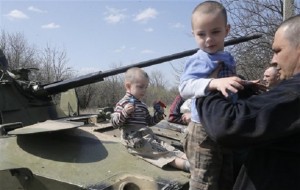57-nation group plays key Ukraine monitoring role

Local residents look at the airborne combat vehicle, which was destroyed during a Ukrainian night combat operation, in the village of Horodychevo, near Kramatorsk, Eastern Ukraine, Friday, April 18, 2014. AP
VIENNA, Austria—A team from the Organization for Security and Cooperation in Europe is going to try to help de-escalate Russian-Ukrainian tensions after the two nations agreed to work on reducing frictions sparked by Moscow’s annexation of Crimea.
But the Special Monitoring Mission of the 57-nation OSCE to Ukraine and other OSCE teams on the ground have no enforcing powers, limiting them to advisory and monitoring roles. The organization — which includes Russia, the United States, Canada, all European and some central Asian countries — also works mostly by consensus, which allowed Russia last month to block its team from going to Ukraine for a week.
A look at the organization’s presence in Ukraine:
____
THE SPECIAL MONITORING MISSION
Article continues after this advertisementThe 100-strong team includes personnel from Russia and the United States and can be expanded to up to 500 people. It was established March 21, with an open-ended mandate to observe and report on the situation in Ukraine.
Article continues after this advertisementAfter a crisis meeting in Geneva on Thursday, the foreign ministers of Ukraine, Russia, the United States and the European Union authorized it to “play a leading role” in assisting Ukraine’s authorities to quell “violence, intimidation or provocative actions.” But Russian endorsement of the team does not recognize any role for it in Crimea, the Ukrainian peninsula that Russia annexed last month.
____
MILITARY VERIFICATION VISITS
Several OSEC teams of unarmed civilian and military were repeatedly blocked from visiting Crimea between March 5 and March 20, as the peninsula veered into Russia’s orbit. The teams were sent at request of Ukraine outside the OSCE consensus rule and did not require Russian approval. They were prevented from entry into Crimea by pro-Russian units—including some who fired warning shots—but were able to report that such units apparently included regular Russian military troops.
____
ELECTION OBSERVERS
The OSCE deployed its first election monitors to Ukraine in March, after Ukraine asked them to observe its May 25 presidential election. The team, which could reach up to 900 members by election day, reports on any irregularities in the vote.
___
HUMAN RIGHTS
An OSCE rights mission met with officials and Russian and Ukrainian minority communities throughout Ukraine including Crimea between March 18 and April 1 and will soon release a report on its findings. The OSCE High Commissioner on National Minorities, Astrid Thors, visited Ukraine, including Crimea, several times in March and April.
___
OSCE MEDIA FREEDOM
OSCE media freedom chief Dunja Mijatovic visited Crimea as well as Kiev in early March and Kiev in April. The OSCE describes her role as providing “early warnings on violations of freedom of expression and media freedom.” She has issued several critical statements about the safety of journalists since the crisis broke.
___
NATIONAL DIALOGUE
At the request of Ukraine, a 15-member team of experts has been deployed in areas of Ukraine outside of Crimea to “support confidence building between different parts of Ukrainian society.”
RELATED STORIES
Ukrainian insurgents reject call to quit buildings
Russia, West reach deal on Ukraine crisis but Obama cautious